The Ruination of Rural America
Ray Stevens, May 2017
I.
"I feel a change in the weather, I feel a change in me,
The air is getting colder and the birds begin to leave,
Even me, yes yes y'all, who has been so long alone,
I'm headed home."
Josh Ritter, "Homecoming"
Two or three times per year, I migrate back to the closest to thing to an ancestral home which I’ve ever known. My parents were wanderers as I was growing up, and when asked for the litany of places we lived before I found four years of stability in college, I have to take a minute. The stops between my current residence and my parents’ house, though, are a map on my heart that I can express in one long exhale:
Albany Warrensburg Indian Lake Blue Mountain Lake Long Lake Tupper Lake Home.
My family only moved to Potsdam, New York officially when I was entering high school, but my mother was raised two towns over, her parents worked their whole careers at the local high school, and for as long as I’ve been alive, it’s been the place we returned to each summer, no matter where else in the country we’d gone to. In the early days, we stayed with my grandparents at the stately Bayside Lodge, which prior to their occupation had been the gatehouse and funeral parlor for a nineteenth-century cemetery. My younger siblings and I played among the headstones from before we knew what they were, but by the time we made our permanent move to Potsdam, my grandparents had been forced to relocate to a small house far out in the woods, pressured to leave by climbing rents and the increasingly severe disrepair of the lodge itself. It’s sat empty since they left; there’s a tree growing out of the chimney now.
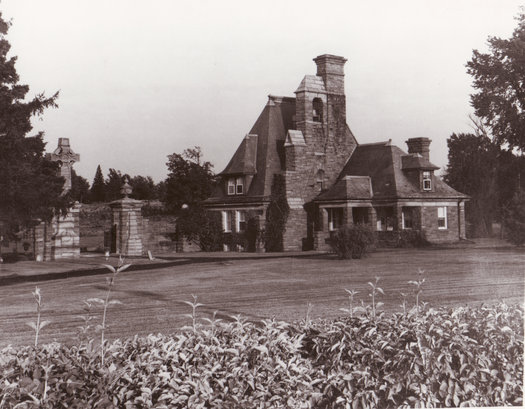
Bayside Lodge, Potsdam, New York (1899).[1]
St. Lawrence County, New York, which is home both to Potsdam and significant portions of the Adirondack National Park, is 94% white and has a per capita income of $22,562.[2] Roughly one fifth of the population lives below the poverty line.[3] St. Lawrence County went for President Trump in November with 52.5% of the vote.[4] This is not, in particular, an article about that, but it bears mentioning that this rural, politically purple region falls precisely within the area of demography which has become so central to our media’s public soul-searching in the last year. What this article is about, at least in part, is that according to the most recent census data, St. Lawrence County, which is over twice the size of Rhode Island, had a population of 110,038 and a population density of 41 people per square mile. My mother worked for that census, and one day, she told me she found eight empty houses on one street, no occupied ones, and nothing else of interest except for a pile of rifle shells on the river shore. But let me back up.
When my family moved to Potsdam during the summer of 2008, having been pushed out of the Houston suburbs by the market crash, I found myself living miles outside of town and not yet possessed of either a driver’s license or any friends. During the two months and change before school began, I found my fun in our new home’s astonishing abundance of birds, and, because I was nearsighted but didn’t know it yet, I borrowed my father’s camera with its zoom lens to get good looks at them all. Pressing the shutter button just became convenient at some point, and thus began a photography habit which continues to this day. I’ve lost interest in birds, though my project does still involve migration of a sort—both my own and that of my subjects.

Hannawa Falls, New York (2016).
For the last two years, I’ve supplemented my income by driving field trips for a local school, always bringing a camera along in case I’m left at loose ends. My migratory range extends across northern Massachusetts and most of New York and Vermont. I describe my hobby as habitual light trespassing and I photograph, specifically, abandoned and falling-down buildings. There are enough of these in every rural area I visit to keep up my practice. These are usually empty houses and relic motels, sometimes burned-down shops. For every abandoned building I visit, I pass by four or five others because they have warnings painted on the door, or are too close to too much traffic, or because I’ve already photographed a dozen that day and am out of memory card space. Sometimes, it’s because despite being able to see sunlight all the way through a building that’s as much hole as wall, I am superstitiously certain that someone is still living there. I occasionally photograph barns, but only ever from the outside, because as my summers farming in St. Lawrence County during high school and college taught me, there is no level to which a barn can degrade—short of a broken spine and total collapse—that its owners will not keep using it. Who can afford to rebuild?

Sodom, Vermont (2017).
The migration of my subjects is trickier. The buildings themselves, of course, do not move: they remain, are remainders, are reminders. Their former residents have flown the coop, and are only known by their absence, by the fact that they are not here anymore, and so this building is like this. That’s not quite right. This building is like this, and so they are not here anymore, could not remain. Migrated.
Entropy, the decline of ordered things into disorder, is an intrinsic and inexorable property of the world. All things eventually, naturally, degrade. Neglect speeds this process, but it’s no one’s fault. It’s hard to argue with the slow unwinding of universe, and rural America has been unwinding for some time. In wandering what’s left behind, though, here’s what’s become very clear to me: ruin is a verb.
II.
"When the oracle spoke to me she was like a roadside song,
Do unto others as you would have them do,
Even if in turn they do you wrong,
This town right here is my everything,
Though I've been torn away."
Josh Ritter, "Homecoming"
Farmland is a site of vivid imagination in America, carrying simultaneously rich resonances of both nostalgic small-town wholesomeness and independence, self-sufficiency, and freedom from all the oppressive trappings, entanglements, and obligations of modern life. In the mind, farmland exists perpetually in the past—and so do the lives (and attitudes) of its people. I would be the last to argue that rural America doesn’t hold dearly some attitudes that it’s easy to call regressive. One of Potsdam’s only claims to fame in recent memory is the national attention we earned with our highly-publicized witch hunt of Nick Hillary, a black resident falsely accused of murdering his ex-girlfriend’s twelve year-old son in 2011.[5] Out on the back country roads, one regularly encounters checkpoints set up to find and detain undocumented workers. In my own family, I have seen my two (younger, black, adopted) siblings go through life with the same upbringing and socioeconomic context as myself, but receive radically different results from every system, beginning with the schools which should be preparing them for success later in life. This discrimination existed as surely for them when we lived in Houston as it does in Potsdam, but: it is in Potsdam. However, it is a racism of and in the present, exactly like all of rural America exists of and in the present. Driving out past the end of the interstate isn’t a form of time travel, as much as it comforts one to think so. The heartland is still here, still now, and neither it nor the city are exempt from each other’s troubles.
The sight of the rural ruin is different things to different people: to the outside viewer, one of my photographs might be a hauntingly beautiful confirmation that agricultural America is of a bygone era—sad, but possessed of what Ann Laura Stoler calls “the redemptive satisfaction of chronicling loss.”[6] To the local, that photograph shows her own barn, ordinary as a shoe, which has broken down over the last decade because each month she cannot seem to budget to keep it from decaying further. The inoperable tiller in the corner isn’t a remnant of a lost era; it is a necessary machine which she’ll get fixed the next time she comes into a windfall. To the local, the eventual collapse of the barn and rusting-out of the tiller is not a foregone future: it is one possible outcome of the work she performs and the choices she makes (and those that are made for her) every day. Ruination in rural America is the result not of some abstract natural progress, nor of dereliction in duties, but of people being prevented from giving care to their own homes and businesses.
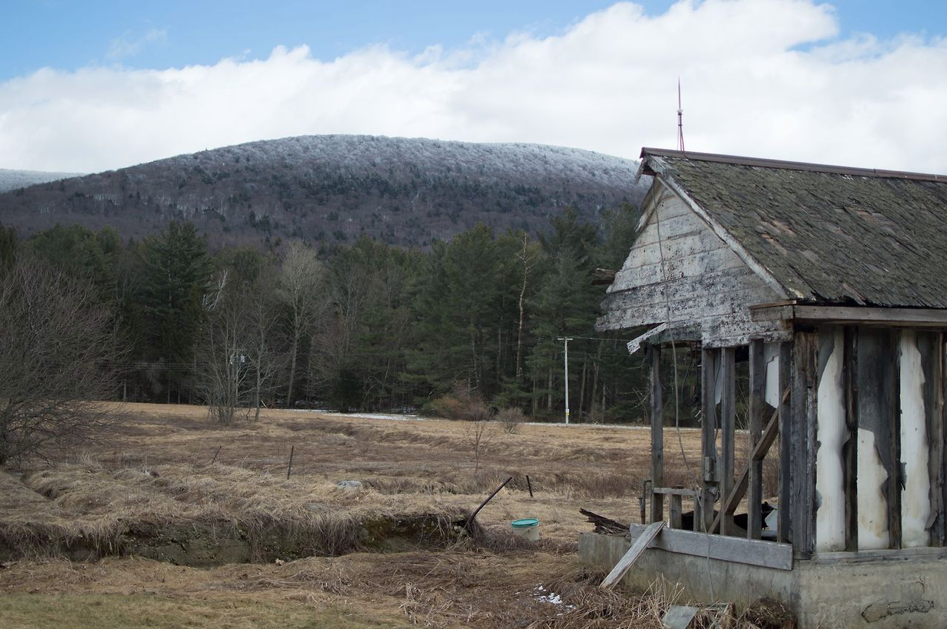
Shaftsbury, Vermont (2017.)
As much as we like to imagine that having a plot of earth to call one’s own and raise food immunizes one to dependence—on capitalism, on the state—it’s never been true. The American agricultural system was built on chattel slavery and state-sponsored land theft from Native Americans, and our nation’s foundational documents are riddled with state support for the imperial project which fostered our system of food production. When slavery ended, sharecropping and tenant farming came to replace it, with poor families living on and working land still owned by former plantation masters in the South.
In the 1930s, the stock market crashed after the grasping financial speculation of the Roaring Twenties backfired, and an historic drought caused by ill-advised farming practices brought the one-two punch of the Great Depression and Dust Bowl. The tenant system of farming collapsed, and families who had worked fields they lived on but didn’t own for generations were evicted en masse by banks and owners scrambling to recoup losses. Diesel tractors, “snub-nosed monsters,” were introduced to replace several families each in the name of cost reduction, and they bulldozed houses as easily as they tilled new rows into the ashes of the land.[7] As the economy and the land gradually recovered in the ensuing years, particularly during the exceptional post-WWII prosperity which has come to be our yardstick for all cultural wellbeing, small farmers came to mostly own their own land, acquiring it and now-necessary expensive tools such as tractors through the power of bank loans and mortgages. Credit and insurance became as integral to the small family farmer as they’d previously been (and still are) to the big boss.
For a few brief years in the 1970s, severe drought struck in multiple places around the globe, but not the States, and at the same time the Nixon administration intentionally weakened the dollar to gain an edge in global exports. Suddenly, American produce was in unprecedented demand. Agricultural property prices and the credit lines of farmers swelled in tandem. Banks and farmers became ambitious, and loose lending policies led to wild expansion of family farming operations. Nothing in the actual conditions of the land had changed, only the markets, but for a few brief years, American farmers made money hand over fist, and for the most part they turned right around and sunk this money back into their farms. Demand for heavy machinery and new pesticides skyrocketed. Then, in the 1980s, the bubble burst: the drought ended and other countries began producing larger quantities of food for themselves, the Federal Reserve moved to cap inflation in a way that sent interest rates through the windshield, and almost immediately thereafter, the Carter administration embargoed exports to Cold War opponents of the States.[8] Farmers scrambled to increase production as grain prices dipped, but this only pushed them lower. The value of farmland crashed, and a mass wave of foreclosures swept the country as if overnight. Banks which had previously been regularly writing farmers checks for more than they’d even applied for were suddenly gripped by caution, and recalled insufficiently secured loans on little to no notice as properties depreciated.[9] The banks blamed the farmers for overreaching, and the farmers blamed the banks for understating the risks. Some farmers fought tooth and nail to keep their homes; others left town in the middle of the night rather than face the shame of eviction. Thousands of farms folded. The Midwest was the hardest hit, but between 1980 and 2012, New York lost two thirds of its dairy operations, first to foreclosures and since then to a growing tide of consolidation by thousand-cow agribusinesses.[10] Without available work, the already-existing trend of rural population loss accelerated considerably, businesses moved out, and local tax revenues and infrastructure declined. The ghost towns of the contemporary heartland took shape, and we haven’t been the same since.
In Potsdam nowadays, the downtown block formed by Market and Main is known for its revolving-door rentals to small businesses, which set up shop buoyed by economic stimulus grants, and fold not long after the support expires. The handful of long-time mainstays on the block have largely also vanished in the years since my family came to town, including Northern Music, which operated independently for forty years and provided records, sheet music, and instrument repair for the Crane School of Music and our local public schools.[11] Aging shop owners facing declining sales find no one to sell to, and cut their losses. As with most rural places, Potsdam sullenly resists the increasing likelihood of forced school mergers to pool resources for a shrinking student-aged population, as schools are perhaps the main remaining sites of town unity and pride. These days, rural America is shrinking by attrition.
Between 2000 and 2015, the portion of the St. Lawrence County population over the age of 65 jumped from 13.0% to 15.8% (compared to 2015’s 14.9% for the US as a whole), and is still climbing.[12] Spaced out as we are, care is made difficult: it’s a half hour each way to drop in on my grandparents in the next village over, and as they age they become less and less able to drive into town themselves. They’re doing well right now, and are generally CNN viewers, but we’ve got a growing problem with senior citizens who sit at home for large portions of the day, cut off from their communities, getting their outside contact from marathoning Fox News, becoming increasingly paranoid about and disillusioned with the state of our nation.
This is not a natural decline. This is the consequence of state policies and capitalist practices which actively produce observable results—ruins—on the landscape. The ruination of rural America is not inevitable: it is being created by the hollowing of social support policy and the habits of banks and corporations. Monsanto is by now famous for its copyrighted crop genetics and its policies which require farmers to buy seeds again every year rather than banking those produced by their crops. John Deere, despite its green-and-yellow color scheme’s synonymity with good country livin’, now mostly pioneers in the field of eviscerating the rights of those who buy from them. Their tractors have long been filled with DRM software and restricted to being serviced by company-approved technicians—a profit-driving privilege which the company has joined forces with Apple to lobby to keep.[13] More recently, Deere & Company has linked up with General Motors to float the idea that under the Digital Millennium Copyright Act, those who buy their products don’t actually own them at all; they’ve simply bought the license to use them for the lifespan of the machine—and anyone who doesn’t want to follow their protocols (and prices) for service is, yes, a legally liable tractor pirate.[14]
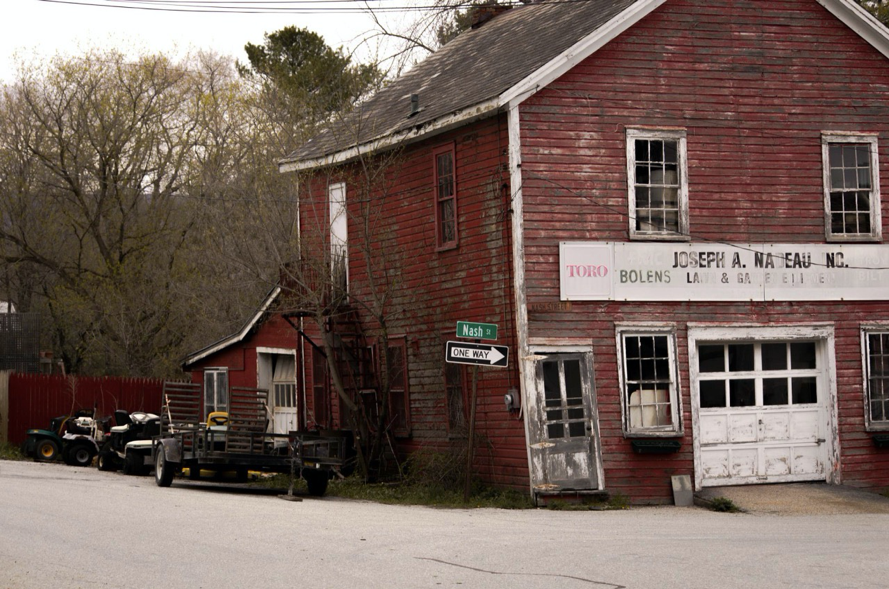
Mower Shop, North Bennington, Vermont (2016).
I do not mean to say that rural America has it uniquely bad, or that the average inhabitants of cities are victimizing our communities for their own gain. What I mean to say is that we are sinking, being ruined actively, and that the forces assailing us assail others too, but that the urban/rural divide in the mind obscures this important fact. During the Depression and the farm crisis of the eighties, banks learned that if they overreached themselves and faltered, there would be mass foreclosures on the homes and livelihoods of those they’d lent to, but they themselves would survive. During the housing crisis of the mid-naughts, they transferred that strategy to the suburbs and cities, again gambling on the most necessary and intimate (and therefore presumed stable) commodities available, and again they brought the world economy to its knees. That time, the banks also learned that sloppy record-keeping can sometimes mean that individuals can’t prove that they don’t owe you money, even if you can’t prove they do—and you’ve got deeper legal coffers and can wait them out until a ruling or a settlement emerges.[15] And again, the banks survived, because when we had to choose between protecting the people and protecting the institutions that keep our finances, we chose the institutions. Now similar strategies have been appropriated back to the countryside, capitalism’s laboratory out of sight of the nation’s daily life. Now power companies experiment with ways to exploit ambiguities in land titles and water access rights from the nineteenth century, in order to claim and flood the homes of those who live along rivers, so that the water—and hydroelectric profits—can run ever higher, and insulate them against oil’s looming decline. A future is being produced out here, for all of us, and in order to alter its course we must first look it in the eye.
III.
"That kind of immemorial, that time before the Fall,
That time before we all really turned a corner,
Drive east of Eden till your start to feel the west,
We were never far from nowhere,
You could see it from the edge of town,
Honey, baby, wonder how it feels now,
Somehow I can't believe that it could feel like before."
Josh Ritter, "Homecoming"
In the recent Marvel film Logan (2017), which depicts the last days of the aging Wolverine’s life in 2029, time is taken away from the action sequences to foreground violence of a more systemic nature. There is a massive, hypersecure border wall between the US and Mexico in 2029. The rural American highways are virtually deserted except for autonomous shipping trucks which have been given absolute right of way, and won’t hesitate to run human drivers off the road. Fields of immense stalks of genetically modified corn are tended by vast machine workers which make a visual impression similar to the tripods from War of the Worlds (2005). Cities seem mostly unchanged, but people are scarce on the wider American landscape, and water is scarcer. Nothing in the film’s spirit of place helps one believe that this future is survivable—even leaving out the paramilitary organization who hunt the protagonists throughout, there is human-made decay everywhere. It’s a masterstroke in the science fictional tradition of using visually-expressed futures to depict the feeling of being in a given day’s present. Logan isn’t genius because our future will look like that. Logan is genius because here, today, anonymous corporate sprawl has bought out your father’s dairy farm, and you’re still in the old house for now, but you need an easement just to get to clean drinking water. You’re not sure whether it’s actually clean, because the standard battery of tests doesn’t include this new PFOA thing everyone’s talking about.[16] The world is full of vast machines that operate heedless of your presence or absence, and the business of producing life is got on with, but it no longer requires you.
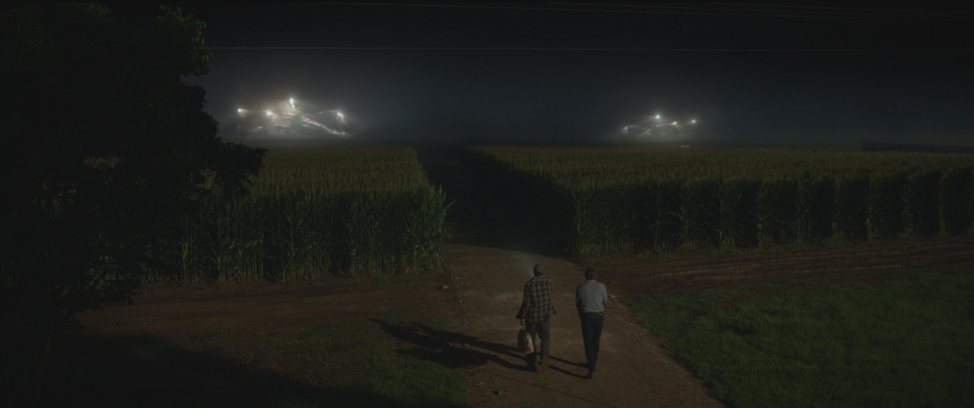
A holdout farmer and the Wolverine observe autonomous mega-threshers farming syrup corn. Logan (2017).
Ruination not only affects the buildings of rural areas, but pervades lives, and is present everywhere, up to and including the bodies of rural people. Bill Prince, the farmer for whom I worked during the summer between my freshman and sophomore years of college, died not long after, at the age of 62, of an unknown condition.[17] During the time I knew him, he was visiting a chiropractor every other week for pain relief, because he could not afford to visit a doctor for actual treatment. Bill was a lifelong volunteer firefighter and former fire chief who knew the area very well, and during our long drives together to pick equipment up or drop produce off, he’d often point out sites of memory on the landscape. That was where the Prestons’ barn burned down going on eight years ago, and a second time last winter. That’s the old house of a buddy of mine, he was a firefighter too, great guy, but then he killed himself two years back. The rest of us try to visit his wife when we can. I don’t remember the stories as well as I would like, but I remember that the number of suicides Bill casually recounted staggered me. Two years later, he was gone too, although not by his own hand. His small vegetable farm, which he bought in 2000 after getting out of the dairy business, may not survive him for long. His wife Lois is a pro, but she’s getting older too and none of their children or grandchildren have learned to work the land—instead, they have jobs repairing trucks or in the check-out lanes at Wal-Mart. This is needed work; small farms are no longer self-sustaining, and the family could not have kept this one afloat for as long as they have without the supplements of other income sources. All the same, it’s easy to see a future in which there is no inheritor for Lois and Bill Prince’s plot of earth, and it passes into the hands of another franchise dairy farm, or goes completely to seed.
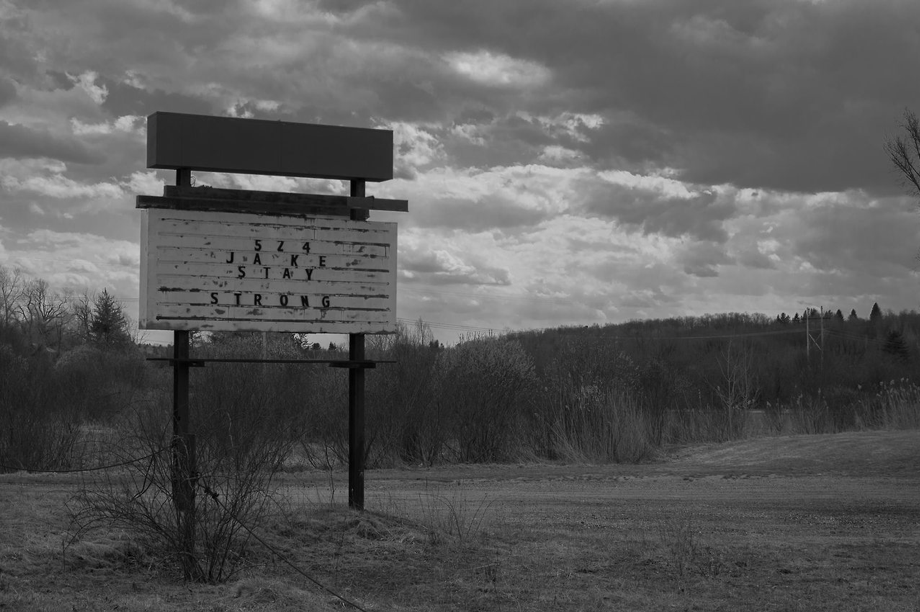
Bill Laston Memorial Park, Lanesborough, Massachusetts (2017).
There is an indescribable immensity of loneliness to looking out over your home hills and seeing so many spaces where people used to be, to realizing suddenly one day that even the absentee farmers who used to come and cut the alfalfa field beside your house stopped three seasons ago, and you didn’t mark it, and you don’t know why. There’s a slow uncomprehending anger that sickens the heart, and will always eventually out. It’s so hard to know exactly where to put it and how. Sometimes, it becomes mere bitterness, spewed late at night around the table, directed by demagogues and long tradition at outsiders or Hollywood fat cats or worse-off neighbors or the whole society, brought out in xenophobia and vicious gossip and conspiracy theory. Sometimes, it’s a bullet in one’s own head, and sometimes, worse, a bullet in someone else’s.[18] Sometimes it’s a vote that will amount to the same. Frequently, I hear it in the utter contempt with which young people who have left speak of the boonies, speak of being from Butt-Fuck Nowhere, Nebraska, speak of Deliverance. I recognize that one most closely. All of these are pointed wrongly, range between the politically paralytic and the monstrous, and in this age of mindful wellness, aren’t we meant to always practice properly directing our emotions? So I’ll tell you where I’m putting mine.
I put my anger into the belief that the core enmity of America today must not be between “real Americans” and “others,” along whichever metric that is meant to be organized, and it must not be between the city and the country. I put my anger into refusing apathy and sentimentality, into refusing to eulogize my home because we still live here. There is no mythic place outside of history where the depredations of capital aren’t happening, so it’s time to dig our heels in here, teach history to those who forget it, and let it inform our efforts for the future. Rural America does not need nostalgia from so-called coastal elites; we need solidarity with other groups who have something to gain from pushing back. So speak with words intended to cut, not those around you, but to the heart of the matter. Recognize that wherever in the country you live, our problems are imposed by the same systems of profit, and our solutions must address that fact. Refuse to lie down. Let humanity be your answer to the dehumanizing conditions amidst which we find ourselves now.
Notes
1 “Sandstone Quarries,” Potsdam Public Museum, http://www.potsdampublicmuseum.org/subpages/74/84/23/sandstone-quarries (accessed 21 May 2017).
2 Per capita income expressed in 2015 dollars. All population stats from “QuickFacts: St. Lawrence County, New York,” United States Census Bureau, https://www.census.gov/quickfacts/table/PST045215/36089 (accessed 21 May 2017).
3 “St Lawrence County, New York,” United States Census Bureau, https://factfinder.census.gov/faces/nav/jsf/pages/community_facts.xhtml?src=bkmk (accessed 27 May 2017).
4 “2016 New York Presidential Election Results by County,” Politico, http://www.politico.com/2016-election/results/map/president/new-york/ (accessed 21 May 2017).
5 Mr. Hillary was found not guilty, but left town the day he received his vindicating verdict in fear for his safety. See Jesse McKinley, “Tensions Simmer as a Small Town Seeks Answers in a Boy’s Killing,” The New York Times, 5 March 2016, https://www.nytimes.com/2016/03/06/nyregion/murder-of-garrett-phillips-in-potsdam-new-york.html?_r=0 (accessed 23 May 2017).
6 Ann Laura Stoler, “Imperial Debris: Reflections on Ruins and Ruination,” Cultural Anthropology vol. 23 issue 2 (2008): 198.
7 John Steinbeck, The Grapes of Wrath, New York: Penguin Books, [1939] 2002 (35).
8 Kathryn Marie Dudley, Debt and Dispossession: Farm Loss in America’s Heartland, Chicago: University of Chicago Press, 2000 (21-41).
9 Ibid. (39).
“Profile of General Demographic Characteristics: 2000,” United States Census Bureau, https://factfinder.census.gov/faces/tableservices/jsf/pages/productview.xhtml?src=CF (accessed 27 May 2017).10 David Sommerstein, “Report Says Consolidation Hurting Farms and Communities,” North Country Public Radio, 26 November 2012, https://www.northcountrypublicradio.org/news/story/20891/20121126/report-says-consolidation-hurting-farms-and-communities (accessed 27 May 2017).
11 Craig Freilich, “To Many, Closure of Potsdam’s Northern Music and Video Marks ‘End of an Era’,” North Country Now, 10 November 2014, http://northcountrynow.com/business/many-closure-potsdams-northern-music-and-video-marks-end-era-0129403 (accessed 27 May 2017).
12 “Profile of General Demographic Characteristics: 2000,” United States Census Bureau, https://factfinder.census.gov/faces/tableservices/jsf/pages/productview.xhtml?src=CF (accessed 27 May 2017).
“St Lawrence County, New York,” United States Census Bureau, https://factfinder.census.gov/faces/nav/jsf/pages/community_facts.xhtml?src=bkmk (accessed 27 May 2017).
13 Olivia Solon, “A Right to Repair: Why Nebraska Farmers are Taking on John Deere and Apple,” The Guardian, 6 March 2017, https://www.theguardian.com/environment/2017/mar/06/nebraska-farmers-right-to-repair-john-deere-apple (accessed 24 May 2017).
14 Kyle Wiens, “We Can’t Let John Deere Destroy the Very Concept of Ownership,” Wired, 21 April 2015, https://www.wired.com/2015/04/dmca-ownership-john-deere/ (accessed 24 May 2017).
15 For notes on the record-keeping practices of bubble-era mortgage suppliers, see George Packer, The Unwinding: An Inner History of the New America, New York: Farrar, Strauss, and Giroux (2013): 268-270.
16 Nathaniel Rich, “The Lawyer Who Became DuPont’s Worst Nightmare,” The New York Times, 6 January 2016, https://www.nytimes.com/2016/01/10/magazine/the-lawyer-who-became-duponts-worst-nightmare.html (accessed 24 May 2017).
17 Names changed to protect the privacy of the family.
18 Laura Beil, “Small Towns Face Rising Suicide Rates,” The New York Times, 3 November 2015, https://www.nytimes.com/2015/11/03/health/small-towns-face-rising-suicide-rates.html?_r=0 (accessed 29 May 2017).
Email: ray(dot)stevens(at)simmons(dot)edu